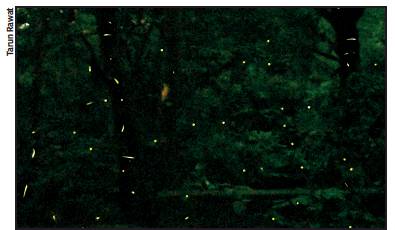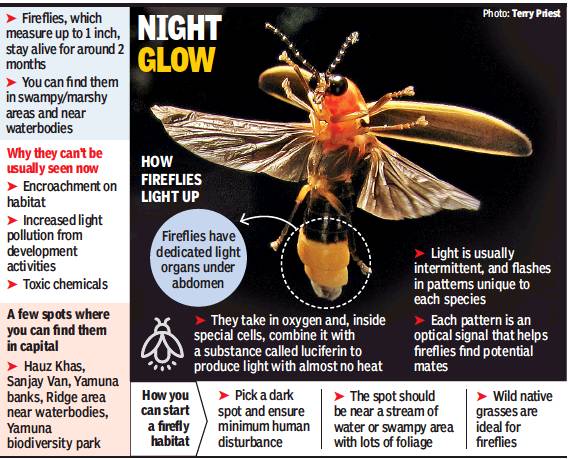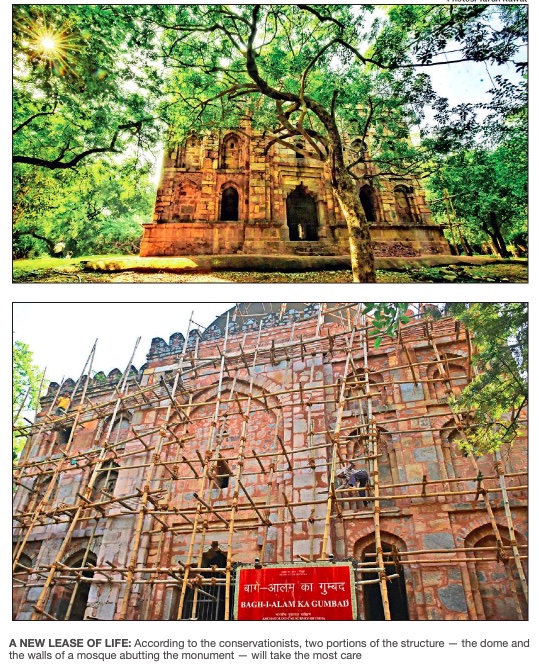Delhi: Hauz Khas
This is a collection of articles archived for the excellence of their content. |
Contents |
Deer Park
Fireflies in August/ 2019
Ritam Halder, August 4, 2019: The Times of India

From: Ritam Halder, August 4, 2019: The Times of India

From: Ritam Halder, August 4, 2019: The Times of India
Secret firefly show in the heart of city thrills nature lovers
Half an hour after nightfall, Deer Park in Hauz Khas was as dark as a cinema. Eager eyes strained to catch the first flicker of the promised show. It wasn’t long before the air started pulsing with hundreds of glowing fireflies. Only 15-odd visitors had this unforgettable experience, as part of the Secret Firefly Walk organised by New Delhi Nature Society. Radhika Bhagat, a city-based environmentalist who was in the group, said, “Watching fireflies glowing all around me is a memory that will stay etched in my mind forever.”
Vivek Badola, from Rohini, had come with his friends. “Last time I saw these, I was 7-8 years old. They used to be around when our area was not so developed,” he said.
Walks kept secret to keep fireflies off selfie glare
The 15-odd participants of Friday evening’s Secret Firefly Walk in Deer Park went home mesmerised. “Even though other people are enjoying the moment with you, the experience is still very personal and reconnects you with your own wild and free side,” said Radhika Bhagat, a city-based environmentalist who took part in the walk. “You feel the jungle within you in the middle of the city,” she added.
Rohini resident Vivek Badola said, “Not many people know about this place, which makes it more interesting. I got to learn so much about fireflies.”
New Delhi Nature Society founder Verhaen Khanna, who led the walk, said, “Many people have never seen fireflies in their entire life, and many have never seen them in Delhi. They stay away from bright lights, so in a bustling city like Delhi it’s hard to find a dark spot with firefly activity.”
Khanna, who has studied fireflies in the Deer Park area for over 10 years, said their numbers have declined there as well. “Half of their habitat was destroyed to build a footpath.” He keeps the walks small and ‘secret’ to not disturb the fireflies. “I keep the location secret so that it does not become a selfie spot that will further endanger the fireflies.”
He recounted how some people once wanted to join his workshop to take fireflies home to show their friends. “I didn’t allow them to attend the workshop, but explained to them how they could start a firefly habitat in their area.”
Fireflies need a dark place with little or no human disturbance, Khanna said. “There should be a stream of water or swampy area with lots of foliage. Wild native grasses are also great.”
Khanna explained that fireflies and glow worms produce light to communicate in a process called bioluminescence. He said Monsoon is the best season to spot fireflies, and they are also abundant in Sanjay Van, the Yamuna’s banks, the Ridge area and Yamuna Biodiversity Park. You might also find them in abandoned construction sites that have water-filled pits and native wild grasses.
“It is one of the most magical experiences that cannot be enjoyed inside a mall. We must learn to respect nature and have compassion for other species in our surroundings,” Khanna said.
Tomb complex
As in 2021
Zumbish, Nov 4, 2021: The Times of India

From: Zumbish, Nov 4, 2021: The Times of India
HKV tomb complex on path to repair amid Covid-19 challenges
Zumbish TNN
Work on the restoration of Bagh-e-Alam ka Gumbad, a Lodhi-era monument in the heart of Deer Park in Hauz Khas Village, began in 2017.
According to the conservationists, two portions of the structure — the dome and the walls of a mosque abutting the monument — will take the most care. The structure built with grey stone ashlars follows the pattern of square Lodhi tombs. Its facades present a semblance of being three-storey tall.
It has a beautifully carved finial made of red sandstone and marble but it is visible only from a certain distance or from the roof of the monument. Historian and author Swapna Liddle said, “The dome and finial at Bagh-e-Alam have often got damaged by vegetation growing there. I am so glad ASI is finally going to restore the monument’s magnificent dome.”
The grilles of the gateway are also to be repaired. The six arched windows, which add to the geometric appeal of the monument, have to be looked at too.
There is an inscription on the tomb that says it is the resting place of Shaikh Shihab-ud-din Taj Khan and was built in 1501-02. “The name Bagh-e-Alam ka Gumbad is evidently a later one,” said a historian. “With time, people forgot the real history of the tomb and begun to use the popular name that was actually related to the garden surrounding the tomb.”
Bagh-e-Alam ka Gumbad is a monument that is under ASI’s protection. It has stood at Hauz Khas since the reign of Sikandar Lodhi (1489-1517), though the original roof of the mosque that also provided cover to the three tombs has long collapsed.